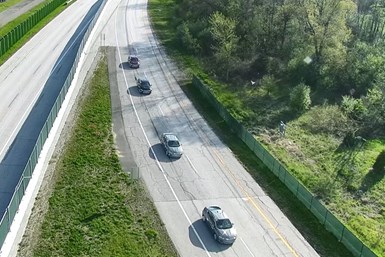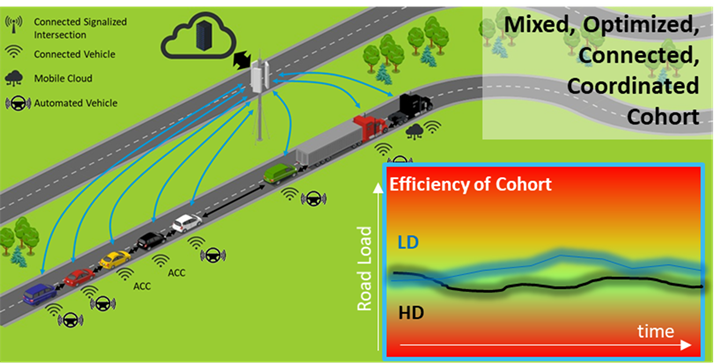Partners Target Improved Powertrain Efficiency Via V2X
Development program is part of new DOE “Grand Challenge”
By sharing data with each other and the infrastructure, vehicles can optimize powertrain efficiency and reduce energy consumption.

Vehicle platooning (Image: Michigan Tech)
That’s the thinking behind a new joint research program that kicks off this month in Michigan. Backed by the U.S. Dept. of Energy, the 27-month project includes AVL, BorgWarner, Navistar and Traffic Technology Services along with researchers at Michigan Technological University and the American Center for Mobility.
Connected Efficiency
The program will use vehicle-to-vehicle and vehicle-to-infrastructure communications to relay information about upcoming traffic and road conditions to better coordinate and optimize vehicle speed and overall traffic flow.

Based on real-time data, route planning and predictive analysis, adjustments will be made to the operating parameters of vehicles traveling near each other to reduce their net energy consumption, according to the partners.
The study will evaluate various types of connectivity, electrification and automation. This includes platooning—where vehicles travel in a tight caravan—and smart adaptive cruise control based on surrounding traffic, upcoming turns and hills.
In addition to highways, the vehicles will be tested over arterial corridors and intersections. In some cases, information from traffic lights and other connected infrastructure will be shared.
Adaptive Propulsion
The project will include a variety of vehicles—including passenger cars and commercial trucks—and propulsion systems.
During the tests, BorgWarner will adapt its transmission, electric motors and engine control systems to optimize performance as conditions change. This includes various levels of hybridization, torque splitting, gearing, driving modes and charging states.
“We believe this joint effort will have a significant impact on energy optimization in the future,” says BorgWarner CEO Frederic Lissalde.
Big Picture
The $2 million program is funded by DOE’s Office of Energy Efficiency and Renewable Energy.
It’s one of 55 projects announced earlier this year under DOE’s Energy Storage Grand Challenge, which aims to accelerate the development, commercialization and utilization of next-generation energy storage technologies.
RELATED CONTENT
-
Things to Know About Cam Grinding
By James Gaffney, Product Engineer, Precision Grinding and Patrick D. Redington, Manager, Precision Grinding Business Unit, Norton Company (Worcester, MA)
-
Jeeps Modified for Moab
On Easter morning in Moab, Utah, when the population of that exceedingly-hard-to-get-to town in one of the most beautiful settings on Earth has more than doubled, some people won’t be hunting for Easter eggs, but will be trying to get a good look at one of the vehicles six that Jeep has prepared for real-life, fast-feedback from the assembled at the annual Easter Jeep Safari.
-
When Automated Production Turning is the Low-Cost Option
For the right parts, or families of parts, an automated CNC turning cell is simply the least expensive way to produce high-quality parts. Here’s why.








